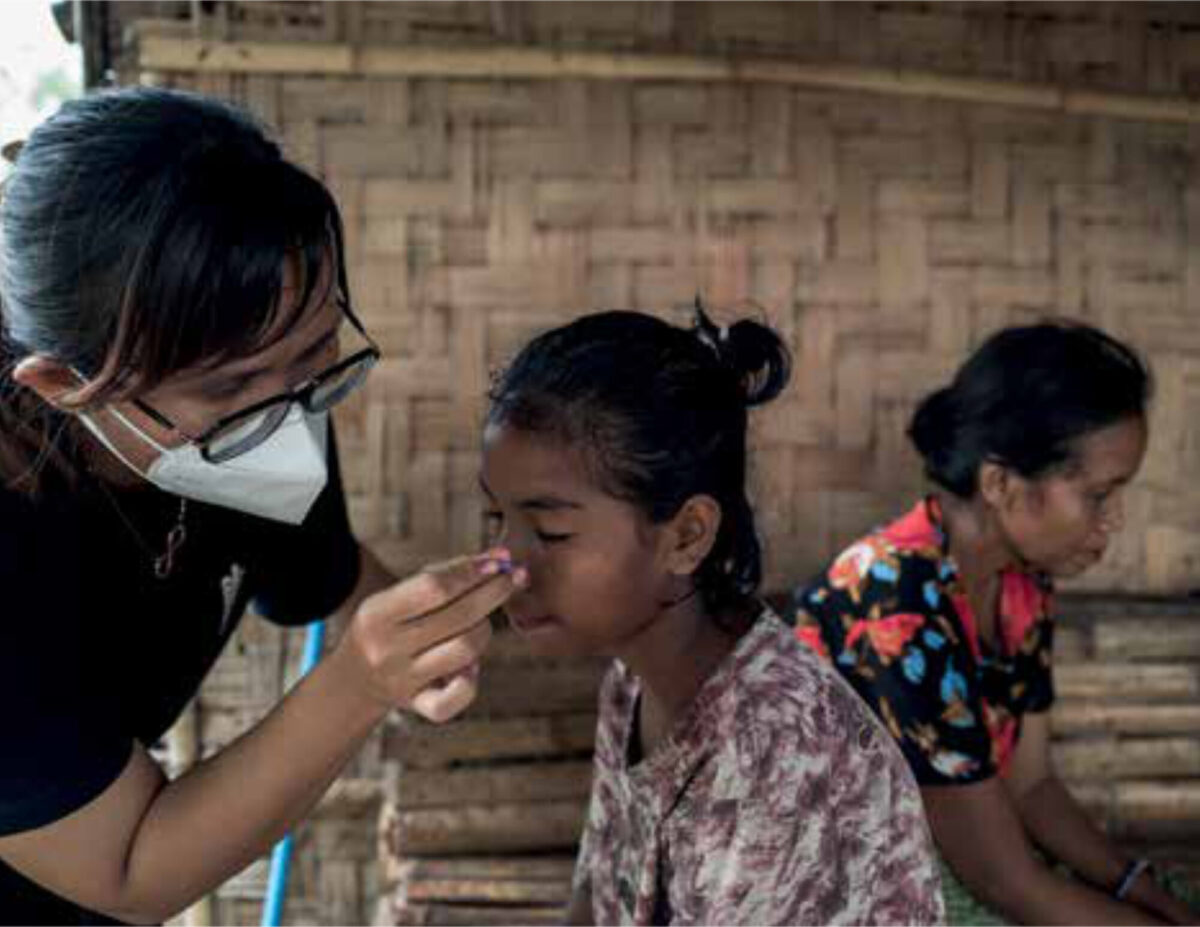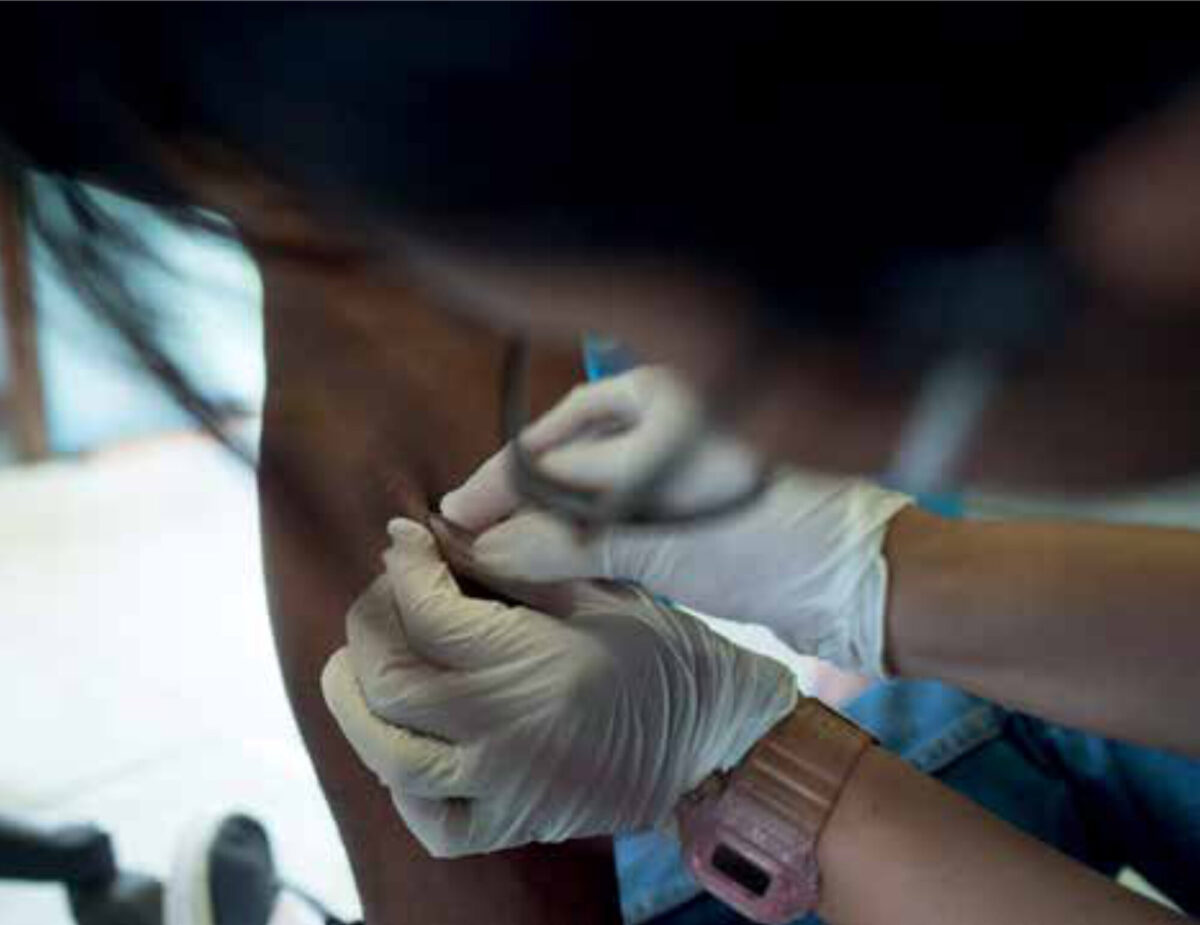Main content
Indonesia
In December 2017, after completing my dermatology residency training in the Netherlands, our family started an exciting new adventure in Indonesia. As a global health dermatologist and research fellow, I am currently based at the Oxford University Clinical Research Unit Indonesia (OUCRU ID) located in Jakarta. The institute works closely with the medical faculties of Universitas Indonesia in Jakarta, Universitas Gadjah Mada (UGM) in Yogyakarta, and many other key partners across the country.
Indonesia is the largest archipelago in the world with more than 17,000 islands spread over 5,000 km. With 278 million inhabitants, Indonesia is the fourth most populous country in the world. There are stark socio-economic differences and health inequalities across the nation. Eastern Indonesia is the least developed, with limited access to health care services and high burdens of neglected tropical diseases (NTDs).[1]

Skin-ntds
It is estimated that one billion people are infected with one or more NTDs with another one billion at risk, disproportionately affecting impoverished communities in (sub)tropical regions. [2] More than half of the 20 NTDs that are recognised by the World Health Organisation are skin-related. Skin-NTDs are common in Indonesia and include leprosy, lymphatic filariasis, scabies, head lice, deep fungal infections, snake bites and yaws. [3,4] The illnesses typically cause disability and disfigurement, which may lead to stigma, discrimination, and mental health problems. Poverty, crowding, malnutrition, and lack of access to clean water are important drivers.
Leprosy and stigma
Leprosy is a skin-NTD that affects more than 200,000 people around the world each year. It is caused by Mycobacterium leprae and M. lepromatosis, primarily affecting skin and peripheral nerves. After India and Brazil, Indonesia has the third highest number of newly diagnosed cases in the world. [5] In 2019, 17,439 newly diagnosed patients were reported: 11% were children, indicating ongoing community transmission, and 6.4% had a visible disability, suggesting considerable diagnostic delays. [6] People affected by leprosy and their family members are often heavily stigmatised, as misconceptions surround the disease and fuel the deep-rooted fears that still exist. [7,8] Leprosy-related stigma is a barrier to implementing effective health care programmes and has a negative impact on health-seeking behaviour, prolonging the risk of transmission, undermining treatment, and thereby increasing the risk of developing disabilities, in turn increasing stigmatisation. [9,10]
Metlep trial
One of the main challenges in the clinical management of leprosy consists of adverse reactions, which are acute immune-mediated episodes that may occur before, during or after multi-drug therapy. [11] Reactions affect 30% to 50% of people with multibacillary leprosy and are the primary cause of irreversible nerve damage, causing disabilities and deformities that are often associated with stigma. [12] Reactions are often chronic and recurrent requiring long-term use of steroids, which create dependency and have many side effects. We therefore designed the MetLep Trial (NCT05243654), a randomised controlled trial evaluating the safety and efficacy of adjunctive metformin in mitigating leprosy reactions in patients with multibacillary leprosy. [13] Metformin, a safe, inexpensive and widely available anti-diabetic treatment, is a promising drug considered for repurposed use as host-directed therapy in tuberculosis (TB) and other communicable and noncommunicable diseases. [14-17] In TB-studies, metformin has been shown to control intracellular mycobacterial growth by increasing host cell viability and reprogramming CD8-T-cells. [18-20] Metformin may positively modify auto-immune cascades that are triggered by the host immune response towards an infection. [20] The MetLep trial has been ongoing since October 2022 at four sites located in leprosy endemic areas in Papua and Sulawesi. To date, 114 participants have been screened of whom 50 have been enrolled in the trial.
In order to optimise the acceptability of the trial and gain a better understanding of the local communities and their contexts, we received additional funding from the Otto Kranendonk Foundation to engage with leprosy endemic communities and perform a community-based knowledge-attitudes-practices (KAP) survey, combined with in-depth interviews and focus group discussions, among persons affected by leprosy, their close contacts, community members and healthcare workers. The study is currently ongoing, and final results are expected in 2026. These activities will improve our understanding of the experiences and perceived barriers for aforementioned groups in terms of illness perception, health-seeking behaviours, access to health care, clinical management, social support and stigma, which may differ across the MetLep trial sites. Study outcomes will guide tailored interventions and engagement activities aimed at improving leprosy literacy in the wider community, reducing stigma, and optimising trial acceptance.
Photo exhibition
Read more about leprosy in eastern Indonesia, and visit our online photo exhibition ‘Letter from the Hills: The Invisible Burden of Leprosy in Sumba’ by Yoppy Pieter, an award-winning Indonesian photographer, at www.invisibleburdenofleprosy.com. This work documents the lives of seven people affected by leprosy from Sumba, revealing their dreams and daily challenges. This exhibition was recently launched during World Leprosy Day 2023 and has also been published in The Lancet.[1] The project was part of a public engagement campaign to raise awareness and highlight the burden of skin diseases in eastern Indonesia.
Funding support: The Knowledge, Attitude, and Practices (KAP) study is supported by the Otto Kranendonk Foundation of the Dutch Society for Tropical Medicine and International Health (NVTG), and an Oxford University Clinical Research Unit (OUCRU) Public Engagement Seed award (Wellcome Trust 106680/Z/14/A). The study is part of the MetLep Trial (NCT05243654) funded by the Leprosy Research Initiative and Turing Foundation.

References
- Pieter Y, Grijsen ML. Picturing health: the burden of leprosy in eastern Indonesia. Lancet. 2022;399(10335):1588-1599.
- Mitra AK, Mawson AR. Neglected Tropical Diseases: Epidemiology and Global Burden. Trop Med Infect Dis. 2017;2(3).
- Adella FJ, Ammah H, Siregar GO, et al. Teledermatology to improve access to and quality of skin care in eastern Indonesia. Accepted in Am J Trop Med Hyg. 2023.
- Wibawa T, Satoto TB. Magnitude of Neglected Tropical Diseases in Indonesia at Postmillennium Development Goals Era. J Trop Med. 2016;2016:5716785.
- World Health Organization. Global leprosy (Hansen disease) update, 2021: moving towards interruption of transmission. Weekly epidemiological record. 2022;97(36):429-450.
- World Health Organization. Global leprosy (Hansen disease) update, 2019: time to step-up prevention initiatives. Weekly epidemiological record. 2020;36(95):417-440.
- Somar P, Waltz MM, van Brakel WH. The impact of leprosy on the mental wellbeing of leprosy-affected persons and their family members – a systematic review. Glob Ment Health (Camb). 2020;7:e15.
- Santacroce L, Del Prete R, Charitos IA, Bottalico L. Mycobacterium leprae: A historical study on the origins of leprosy and its social stigma. Infez Med. 2021;29(4):623-632.
- Van’t Noordende AT, Lisam S, Ruthindartri P, et al. Leprosy perceptions and knowledge in endemic districts in India and Indonesia: Differences and commonalities. PLoS Negl Trop Dis. 2021;15(1):e0009031.
- van ‘t Noordende AT, Korfage IJ, Lisam S, Arif MA, Kumar A, van Brakel WH. The role of perceptions and knowledge of leprosy in the elimination of leprosy: A baseline study in Fatehpur district, northern India. PLoS Negl Trop Dis. 2019;13(4):e0007302.
- Walker SL, Lockwood DN. Leprosy. Clin Dermatol. 2007;25(2):165-172.
- Rodrigues LC, Lockwood DNJ. Leprosy now: epidemiology, progress, challenges, and research gaps. The Lancet Infectious Diseases. 2011;11(6):464-470.
- Krismawati H, Muchtar SV, Rahardjani M, et al. Metformin as adjunctive therapy in combination with multidrug treatment for multibacillary leprosy: A protocol for a randomized double-blind, controlled Phase 2 trial in Indonesia (MetLep Trial). Wellcome Open Res. 2023;8:289.
- Bramante CT, Buse JB, Liebovitz DM, et al. Outpatient treatment of COVID-19 and incidence of post-COVID-19 condition over 10 months (COVID-OUT): a multicentre, randomised, quadruple-blind, parallel-group, phase 3 trial. Lancet Infect Dis. 2023;23(10):1119-1129.
- Padmapriydarsini C, Mamulwar M, Mohan A, et al. Randomized Trial of Metformin With Anti-Tuberculosis Drugs for Early Sputum Conversion in Adults With Pulmonary Tuberculosis. Clin Infect Dis. 2022;75(3):425-434.
- Bramante CT, Buse J, Tamaritz L, et al. Outpatient metformin use is associated with reduced severity of COVID-19 disease in adults with overweight or obesity. J Med Virol. 2021;93(7):4273-4279.
- McDonagh MS, Selph S, Ozpinar A, Foley C. Systematic review of the benefits and risks of metformin in treating obesity in children aged 18 years and younger. JAMA Pediatr. 2014;168(2):178-184.
- Naicker N, Rodel H, Perumal R, et al. Metformin Increases Cell Viability and Regulates Pro-Inflammatory Response to Mtb. Infect Drug Resist. 2023;16:3629-3638.
- Böhme J, Martinez N, Li S, et al. Metformin enhances anti-mycobacterial responses by educating CD8+ T-cell immunometabolic circuits. Nat Commun. 2020;11(1):5225.
- Singhal A, Jie L, Kumar P, et al. Metformin as adjunct antituberculosis therapy. Sci Transl Med. 2014;6(263):263ra159.



















































